VIAFLUOR® SE CELL PROLIFERATION KITS
Cell Proliferation Monitoring by Flow Cytometry
Cell proliferation dyes diffuse passively into live cells and are used for long-term cell labeling. They are initially non-fluorescent esters, but are converted to fluorescent dyes by intracellular esterases and will covalently react with amine groups on intracellular proteins at the same time, forming fluorescent conjugates that are retained in the cell. Immediately after staining, a single bright fluorescent population will be detected by flow cytometry. Each cell division that occurs after labeling is revealed by the appearance of a successively dimmer fluorescent peak on a flow cytometry histogram (Figs. 1&2). Cell proliferation dyes can be used to track cell divisions in vivo or in vitro. The staining can withstand fixation and permeabilization for subsequent immunostaining.
ViaFluor® SE Cell Proliferation Kits
CFSE (also known as CFDA-SE or carboxyfluorescein diacetate, succinimidyl ester) has been used for many years to monitor cell proliferation by flow cytometry. While several alternatives have been developed in more recent years, CFSE remains popular and widely used. Biotium continues to offer CFSE under the tradename ViaFluor® CFSE. However, CFSE has several drawbacks including leakage from the cell, cell toxicity, and bleed-through into the PE and PE-TexasRed® channels. ViaFluor® 405 SE and ViaFluor® 488 SE cell proliferation dyes were developed at Biotium to provide superior cell staining, fixability, and low toxicity. ViaFluor® 405 is excited with the violet laser and detected in the Pacific Blue® channel, and gives great peaks with no toxicity (Fig. 1). ViaFluor® 488 and ViaFluor® CFSE are both detected in the FITC channel, but ViaFluor® 488 was developed as a less toxic, less leaky and more fixable alternative to the classic dye CFSE. It also has less bleed-through into other channels such as PE and PE-Texas-Red®.
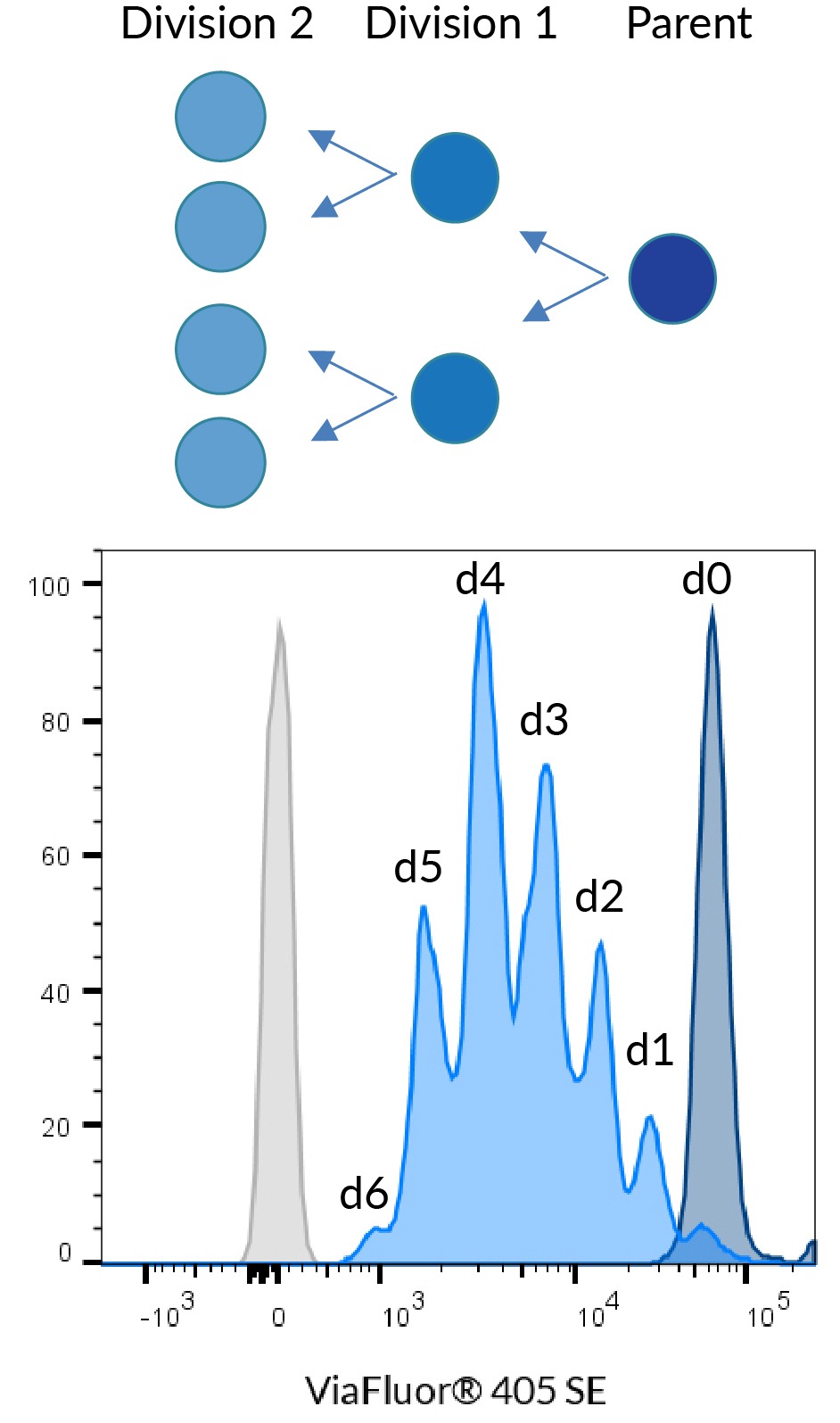
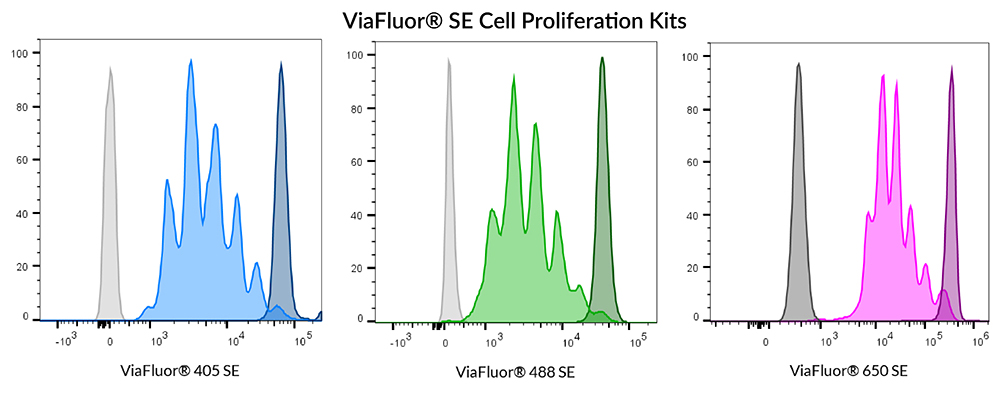
Cell Division | Catalog No. | Ex/Em (nm) | Flow detection | Features |
|---|---|---|---|---|
| ViaFluor® 405 Cell Proliferation Kit | 30068 | 408/452 | Pacific Blue® | • Track cell division by dye dilution using flow cytometry • ViaFluor® 488 is a unique, improved green dye to replace CFSE • ViaFluor® 405 replaces CellTrace™ Violet • ViaFluor® 650 replaces CellTrace™ Far Red |
| ViaFluor® 488 Cell Proliferation Kit | 30086 | 493/532 | FITC | |
| ViaFluor® 650 Cell Proliferation Kit | 30139 | 653/682 | APC | |
| ViaFluor® CFSE Cell Proliferation Kit | 30050 | 495/519 | FITC |
VIAFLUOR® 405 FOR THE VIOLET LASER
ViaFluor® 405, a high-performance cell proliferation dye
Developed by Biotium, ViaFluor® 405 is an excellent choice for a cell proliferation dye. Unlike some other dyes, it is non-toxic to cells (Fig. 6), and does not interfere with cellular processes such as cell cycle progression or T cell activation. The signal is bright and stable, giving nice, sharp peaks that allow you to easily track cell division cycles by flow cytometry. When compared to the popular cell proliferation dye CellTrace™ Violet, we find that they look essentially identical in terms of staining pattern (Fig. 3) and lack of toxicity.
VIEW & Purchase
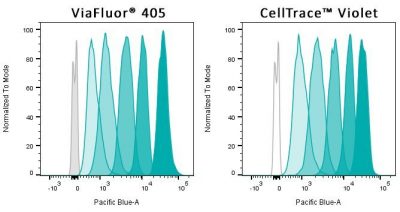
VIAFLUOR® 488: AN IMPROVED CFSE ALTERNATIVE
ViaFluor® 488 for the FITC channel
Although CFSE remains popular and widely used, Biotium recognized that CFSE has several flaws that can interfere with experiments: it shows cell toxicity (Fig. 6), can alter the kinetics of T cell activation, is not well retained in the cell (Fig. 4), is not well retained after fixation (Fig. 8), and bleeds into other detection channels (Fig. 9). Therefore Biotium has developed a new green cell proliferation dye, ViaFluor® 488, that improves on all of these properties.
ViaFluor® 488 gives nice sharp peaks for each cell division and does not show any leakage after washing, unlike CFSE (Fig. 4). ViaFluor® 488 is retained in the cell after fixation and permeabilization (Fig. 7), allowing samples to be immunostained or stored. And ViaFluor® 488 shows less bleed-through into other detection channels such as PE or PE-TexasRed®, allowing more co-staining options. Since ViaFluor® 488 is detected in the same channel as CFSE, current users of CFSE can easily change to include ViaFluor® 488 in their flow panel design.

VIAFLUOR® 650 FOR THE APC CHANNEL
ViaFluor® 650 offers sharper and more distinct peaks than CellTrace™ Far Red
ViaFluor® 650 was designed as an improved and cost-effective alternative to CellTrace™ Far Red for monitoring cell proliferation in the APC channel.
ViaFluor® 650 provides sharper proliferation peaks than CellTrace™ Far Red, allowing more robust cell division tracking (Fig. 5). In addition, each vial of ViaFluor® 650 contains enough dye to stain a much larger volume of cells, leading to significant cost savings.
VIEW & Purchase
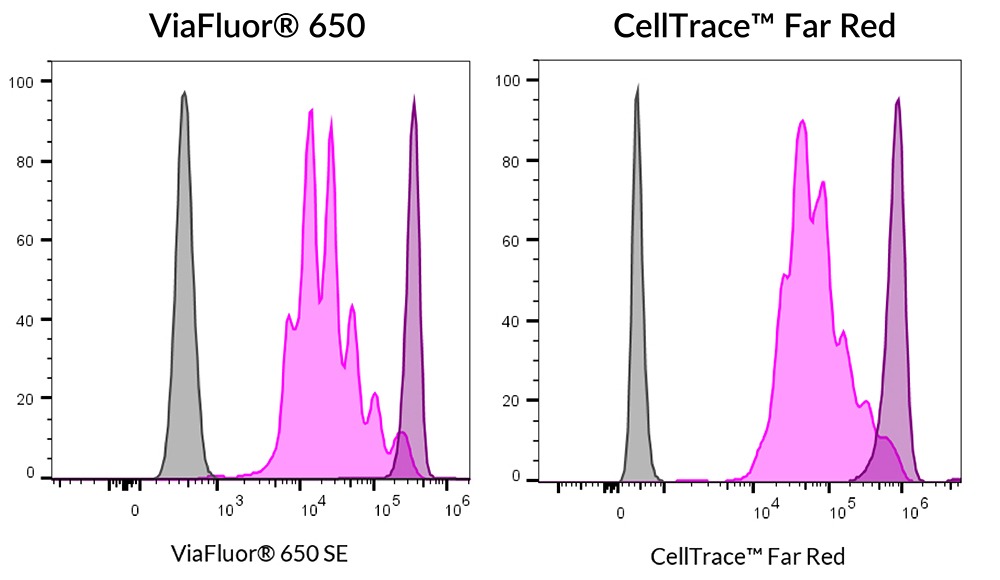
REDUCED CELL TOXICITY
New dyes with reduced toxicity compared to CFSE
Many cell proliferation dyes on the market are toxic to cells when used in the typical assay concentration range of 1-5 uM. This is especially problematic for proliferation assays that often last for many days. We have found that some of these dyes cause cell death and/or cell cycle arrest. The classic proliferation dye CFSE has significant toxicity at 5 uM (Fig. 6) and moderate toxicity at 1 uM, typical dye concentrations for cell proliferation assays. At Biotium we have developed several new cell proliferation dyes specifically designed to be less toxic to cells, for superior performance.
ViaFluor® 488 SE is a green cell proliferation dye, designed as an improvement to CFSE. ViaFluor® 488 has many advantages over CFSE, including reduced cell toxicity. When used at 5 uM, CFSE is extremely harmful to cells, while in the same experiment ViaFluor® 488 is much less destructive (Fig. 6). At 1 uM, we haven’t seen any toxicity at all with ViaFluor® 488.
ViaFluor® 405 SE does not show any toxicity when used at 5 uM in either cultured Jurkat cells (Fig. 7) or PBMCs. ViaFluor® 405 is equal to CellTrace™ Violet in terms of lack of toxicity and great peaks in flow cytometry.

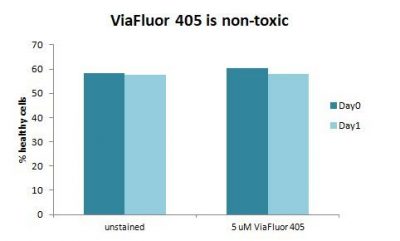
IMPROVED FIXABILITY
ViaFluor® 488 does not lose signal after fixation or incubation
One known problem with CFSE is that it is not well-retained by cells. After staining cells with CFSE and incubating overnight, you find a wide gap between the Day 0 and Day 1 peaks. This is not just due to signal being diluted by cell division, since other proliferation dyes like ViaFluor® 405 and ViaFluor® 488 do not have this wide gap. This is likely due to poor reactivity of the cleaved version of the CFSE dye.
For the same reason, CFSE is also poorly fixable, showing a similar loss of signal after fixation, permeabilization and washing. The improved green proliferation dye ViaFluor® 488 is extremely well retained in cells after incubation or fixation (Fig. 8). The ability to perform fixation and permeabilization without loss of signal allows you to combine the cell proliferation assay with immunostaining and many other cellular assays.
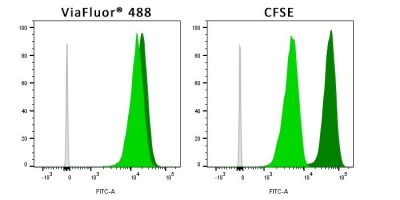
LESS BLEED-THROUGH
ViaFluor® 488 has less bleed-through compared to CFSE
Another issue with CFSE is substantial bleed-through from the FITC channel into nearby longer wavelength detection channels such as PE and PE-TexasRed®. This can present a problem when designing multi-color flow experiments. Biotium’s green ViaFluor® 488 proliferation dye has drastically reduced spillover into nearby channels (Fig. 9), thus allowing it to be used together with other dyes such as R-PE or CF®594.

Pacific Blue and Texas Red are registered trademarks of Thermo Fisher Scientific; CellTrace is a trademark of Thermo Fisher Scientific.
Associated products
ViaFluor® SE Cell Proliferation Kits
30139, 30139-T, 30068-T, 30068, 30086-T, 30086, - 30050View allHide
Live-or-Dye™ Fixable Viability Staining Kits
32022, 32022-T, 32021, 32021-T, 32016, 32017, 32018-T, 32002-T, 32014-T, 32003-T, 32009-T, 32004-T, 32012-T, 32015-T, 32005-T, 32007-T, 32006-T, 32013-T, 32008-T, 32011-T, 32018, 32002, 32014, 32003, 32009, 32004, 32012, 32005, 32006, 32015, 32007, 32013, 32008, - 32011View allHide
Live-or-Dye NucFix™ Red Staining Kit
32010, - 32010-TView allHide
